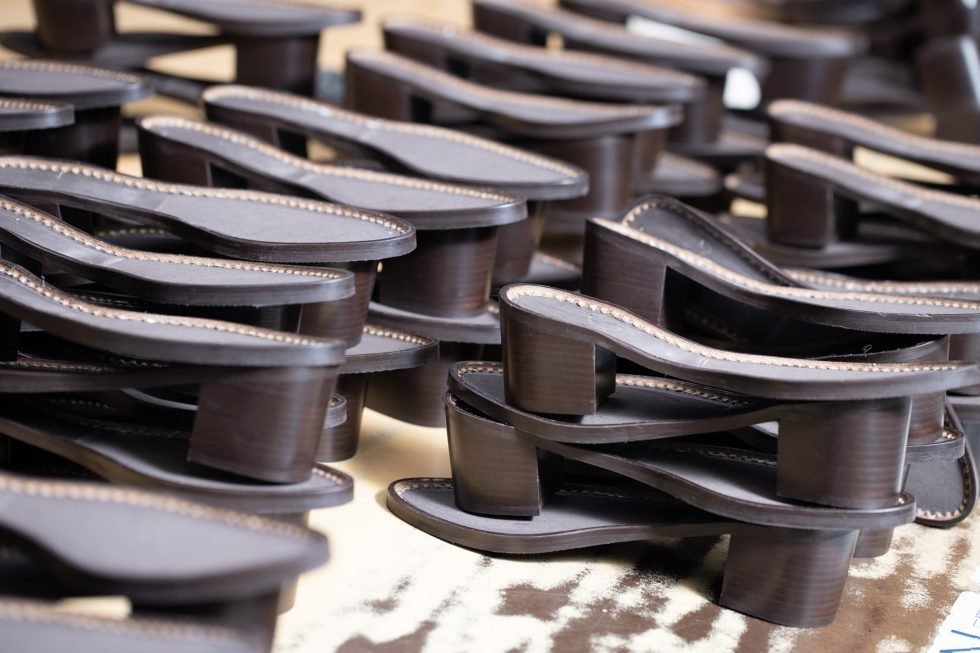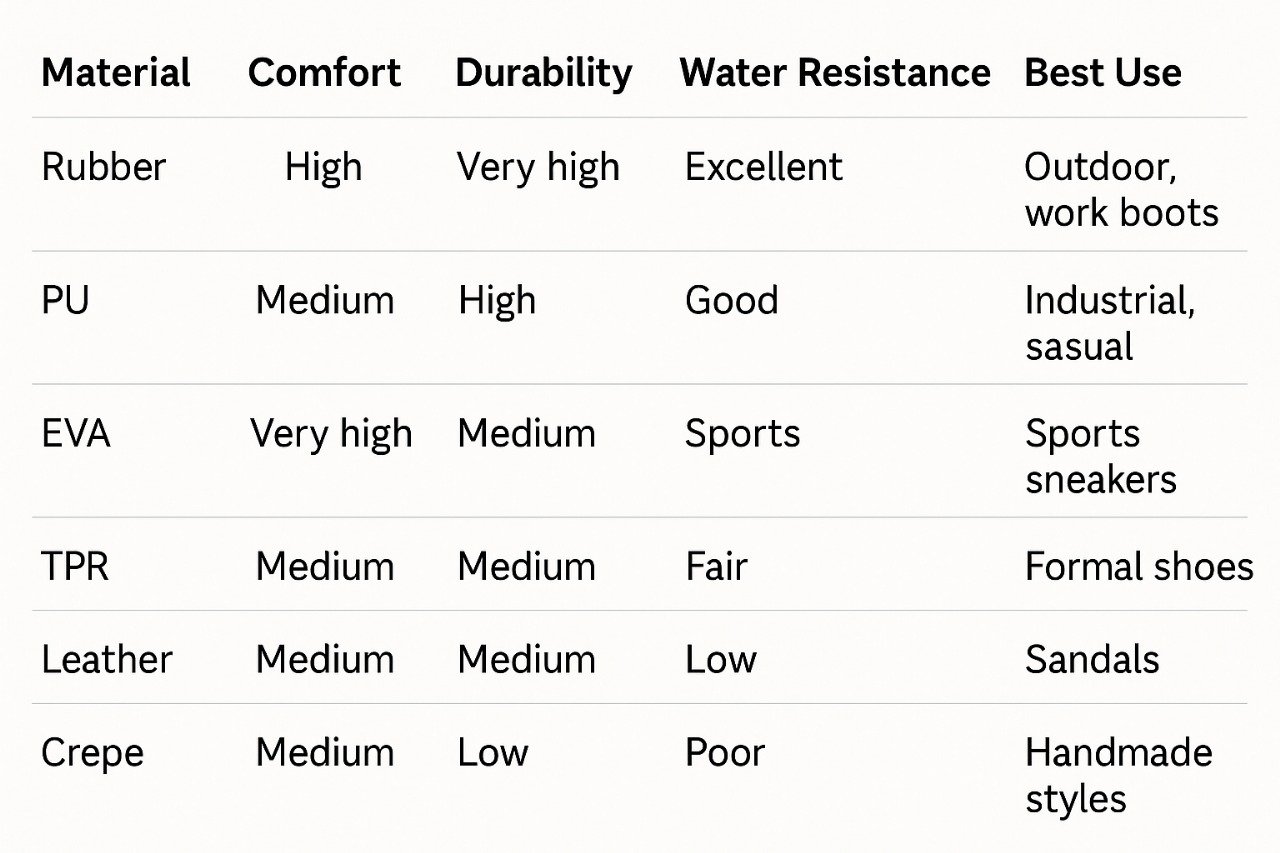
May 2, 2024
The sole of a shoe does more than just support your steps—it defines the performance, durability, and comfort of your footwear. Whether you’re walking city streets in India or hiking trails in the USA, choosing the right sole material matters. At Kiwiind, we prioritize functionality and design in every product, using only the highest-quality materials tailored to our customers’ needs.
What are the soles of shoes?
Understanding the basic structure of a shoe sole helps in appreciating the role of each component:

- Outsole: The outermost layer that contacts the ground. Key for grip and durability.
This is where the rubber hits the road. Typically made from synthetic compounds or rubber, this rubber provides significant durability and traction.
How you deal with different surfaces is greatly influenced by the design and texture of the outsole. While some outsoles are designed for walking around the city, others are made for mountain trekking.
- Midsole: This layer is the foundation of a shoe’s comfort and is positioned between the insole and outsole. It is the region that cushions and absorbs shock, preventing your feet from suffering with each stride.
Depending on the function of the shoe, different materials are used for the midsole; performance shoes tend to use stronger, more supportive materials, while leisure shoes use softer materials for more cushioning.
- Insole: This is the initial point of contact between your foot and the shoe. There are many different types of insoles; some are padded for extra comfort, some provide arch support, and some are even made with orthopedic needs in mind. These can be removed or put back on again and again to suit personal preference, making them the unsung heroes of foot comfort.
Together, these layers create a sole that serves as more than just a protective barrier. It’s a dynamic system designed to maximize your enjoyment of each step. The sole of your favorite shoe is where the magic happens, providing comfort, support, stability, and grip.
Why are the soles of shoes important?
Our shoes’ soles are more than just a small component. They are essential to the entire shoe experience.
- Shock Absorption: Reduces Impact on Joints
With every step, your body experiences impact—especially through the heels and arches. Quality soles act like shock absorbers, cushioning this repeated force to prevent stress from transferring to your knees, hips, and lower back. For people who walk or stand all day, or runners pounding pavement, the right sole can mean the difference between comfort and chronic joint pain.
- Grip & Traction: Prevents Slips and Falls
The outsole of a shoe is responsible for keeping you steady. Whether you’re navigating slick city streets, wet sidewalks, or rugged terrain, a good sole provides reliable traction. This helps prevent slips, trips, and falls—especially important for those in outdoor, industrial, or rainy environments. At Kiwiind, we ensure every outsole is designed with stability in mind.
- Arch Support: Aids in Distributing Weight Evenly
Not everyone’s feet are shaped the same—some arches are high, some flat. That’s why arch support is so critical. A well-constructed sole with proper arch support distributes body weight evenly, reduces pressure points, and supports proper alignment. This helps reduce fatigue and long-term issues like plantar fasciitis, particularly for those on their feet for extended periods.
- Durability: Extends Shoe Life
The durability of your shoes largely depends on the sole. It endures the wear and tear of daily use—from concrete to gravel to moisture exposure. High-quality sole materials like rubber or PU help shoes last longer without flattening, cracking, or losing shape. Investing in durable soles means less frequent replacements and more value for your money.
- Style: Adds Personality and Visual Appeal
Soles are no longer just functional—they’re fashionable too. Thick platform soles, bold colors, minimalist edges, or lug patterns can define your entire look. Whether you prefer sleek formal wear or trendy sneakers, the sole plays a vital role in aesthetic expression. At Kiwiind, we craft soles that balance design innovation with performance.
What are the different materials used for the soles of shoes?
When it comes to the soles of shoes, it’s a whole world of materials out there, each bringing its unique strengths to the table. These materials are chosen based on what the shoe is meant to do — cushion your run, survive rough trails, or add elegance to your stride on city streets. Let’s take a closer look at some of these materials and see what they bring to your footwear.
Let’s break down the most popular shoe sole materials to help you choose wisely:
Popular Shoe Sole Materials
Here’s a closer look at the materials most commonly used in quality footwear, each offering unique advantages depending on your lifestyle, environment, and comfort needs:
Rubber
Rubber is a classic sole material known for its superior durability and traction. It performs exceptionally well in wet, rugged, and high-activity environments, making it a top choice for outdoor and industrial use.
Pros: Excellent grip, weather-resistant, durable
Best For: Outdoor shoes, rainy climates, work boots
Cons: Heavier than alternatives
Polyurethane (PU)
PU soles offer a great balance of flexibility, lightweight comfort, and resistance to oils and chemicals. They are ideal for industrial settings or daily wear where comfort and toughness are both essential.
Pros: Lightweight, flexible, oil- and chemical-resistant
Best For: Safety footwear, casual wear
Cons: Can degrade with heat and moisture exposure
EVA (Ethylene Vinyl Acetate)
EVA is a soft, foam-like material favored for its cushioning and ultra-lightweight feel. Commonly found in sneakers and athletic shoes, it absorbs impact and offers everyday comfort.
Pros: Extremely lightweight, soft, great shock absorption
Best For: Running shoes, sneakers, casual everyday shoes
Cons: Compresses over time; less durable than rubber
Thermoplastic Rubber (TPR)
TPR combines the flexibility of rubber with the ease of molding plastic. It delivers decent comfort and aesthetic appeal at an affordable cost, making it popular for fashion-forward styles.
Pros: Good elasticity and finish, cost-effective
Best For: Casual and fashion shoes, heels for women
Cons: Becomes rigid in colder temperatures
Leather
Leather soles are elegant, breathable, and mold to your feet over time, offering a sophisticated look and feel. They’re commonly used in formal and bespoke footwear.
Pros: Classic appearance, breathable, molds to foot
Best For: Formal wear, designer and bespoke shoes
Cons: Not water-resistant, requires maintenance
Cork
Cork soles provide a natural, eco-friendly option with excellent cushioning. Lightweight and moldable, they are well-suited for orthopedic and ergonomic designs.
Pros: Lightweight, sustainable, cushioning
Best For: Sandals, orthopedic shoes
Cons: Not suitable for wet environments
Crepe
Crepe is a soft, crinkled rubber used in handmade and desert boots. It offers flexibility and a natural look, though it’s less practical in messy or wet conditions.
Pros: Flexible, soft, artisanal feel
Best For: Desert boots, handmade shoes
Cons: Attracts dirt, wears faster
Quick Comparison Table

How to Choose the Right Sole Material
Selecting the right sole material is like picking the best tires for your vehicle — your comfort, safety, and performance depend on it. Every shoe sole has a specific strength, and your ideal choice depends on how and where you plan to wear your shoes. Here’s a breakdown of the key factors to consider:
Assess Your Activity Needs
Are you someone who runs daily, hikes on rugged terrain, or spends long hours on your feet? Your activity directly impacts the type of sole you should choose.
- For runners or active walkers, choose EVA or Rabbit Foam™. These materials are known for their lightweight construction, bounce, and shock-absorbing qualities.
- For outdoor enthusiasts, such as hikers or workers in tough environments, opt for Rubber or PU. These materials offer better traction, resilience, and protection on uneven or slippery surfaces.
Comfort Requirements
Comfort is non-negotiable in footwear. The cushioning and flexibility of the sole can drastically change how your feet feel by the end of the day.
- EVA and PU are excellent choices for people looking for all-day cushioned support.
- For dressier options like heels for women, TPR is a solid choice—it’s flexible and offers a smoother walking experience without compromising on style.
Durability Expectations
How long do you want your shoes to last? That’s where durability comes into play.
- Rubber and PU are both built for longevity and can handle daily wear and tear exceptionally well.
- If you prioritize lightweight comfort over extended wear, EVA is a great pick—but note that it compresses over time and may need replacement sooner.
Adaptability to Weather and Environment
Your local weather and surroundings matter more than you think.
- Rubber soles are ideal for wet, rainy, or snowy conditions thanks to their excellent water resistance and grip.
- Leather soles work best in dry, indoor environments where elegance and breathability matter more than traction.
Personal Style Preferences
Your sole isn’t just functional—it’s a part of your style statement.
- Leather soles offer a refined, formal aesthetic perfect for boardrooms or dress occasions.
- EVA and TPR provide a sportier, more modern look and are common in sneakers, casuals, and fashion-forward designs.
Foot Health and Support
If you have specific foot concerns like flat feet or need extra arch support, the choice of sole becomes even more important.
- Look for midsoles with built-in arch support and cushioning.
- Cork or custom orthopedic inserts can offer personalized support, especially in sandals or medical footwear.
Which Sole Material Is Right for You?
Choosing the right sole material is more than a technical detail—it’s about matching your lifestyle, environment, and comfort needs. Whether you’re after flexibility for long workdays, traction for the outdoors, or elegance for formal occasions, your sole choice matters.
At Kiwiind, we believe a great shoe starts from the ground up. That’s why we use only the highest-quality materials—from durable rubber to stylish leather and cushioned EVA—to craft footwear that performs, lasts, and looks good doing it.
Whether you’re a brand seeking a private label shoe manufacturer, a retailer needing custom shoe manufacturing, or an individual looking for comfort and durability—we’re here to walk every step with you.
Explore our full range of services or get in touch with Kiwiind to start crafting shoes that stand out—one sole at a time.
Conclusion
The choice of shoe sole material significantly influences footwear’s overall comfort, durability, and performance. Whether favoring the classic elegance of leather, the versatility of rubber, or the lightweight cushioning of foam, there exists a sole material to suit every preference and need. By understanding the properties and characteristics of different sole materials, you can make an informed decision when selecting your next pair of shoes.
FAQs
Which sole material is best for daily use?
EVA and PU are preferred for their comfort and lightweight properties.
What does PU sole mean?
PU stands for Polyurethane, a strong, flexible, and lightweight material ideal for industrial and casual shoes.
Is rubber better than PU for durability?
Rubber offers more durability and traction, while PU is lighter and more shock-absorbing.
Are leather soles good for walking?
Yes, especially for indoor or dry weather conditions. They offer great comfort and an elegant look.
Is cork eco-friendly and durable?
Cork is sustainable and offers great comfort, though it’s less durable in wet environments.




